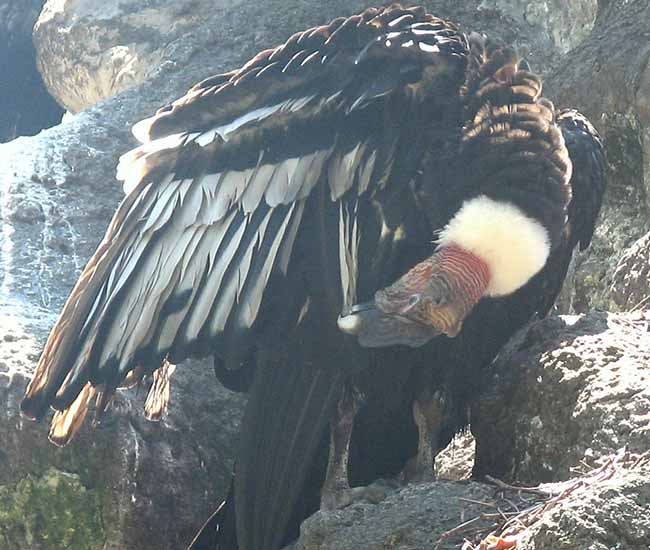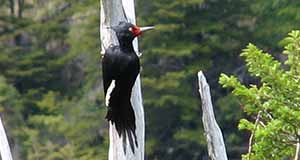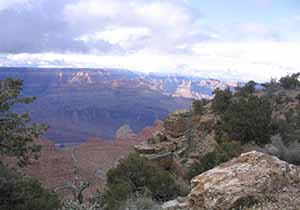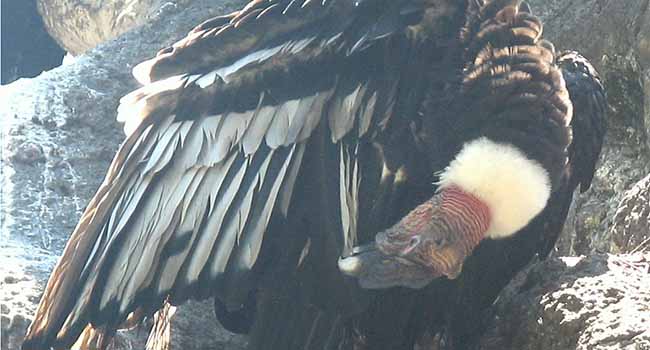
The California condor is a vulture that may live as long as 60 years. With a massive wing span exceeding 2.9 metres, it historically existed from British Columbia to northern Baja, Calif. – photo by Geoff Carpentier
 I’ll tell you the beginning and the end of the story first because they have nothing to do with California condors and everything to do with them.
I’ll tell you the beginning and the end of the story first because they have nothing to do with California condors and everything to do with them.
My first sighting of condors was on a cloudless day in January 1995. We were travelling from Apartaderos to Timotes in Venezuela along the spine of the Andes. I spotted a large soaring raptor, then two, then three and finally five, as they worked a thermal high above the mountain above us.
Soon we determined that these were Andean condors, all sporting their sub-adult gray plumage. What a thrill!
It dawned on us quickly that the Andean condor had been extirpated from Venezuela in the early 1900s, so it seemed highly unlikely that they would be found here today. But there they were.
We later learned that the species was rediscovered in 1976 near the Paramo del Tetari, close to where we stood, but its status was uncertain.
Nearby, we found a small research camp where the residents were studying the birds and had four free-flying sub-adults in their care.
With some excitement we drove up to their field office and enquired about the birds. They told their story and we told ours – a fifth bird had joined their quartet.
| RELATED CONTENT |
| Why have we become a nation of litterbugs? By Geoff Carpentier |
| In search of Borneo’s elusive ‘man of the forest’ By Geoff Carpentier |
| When is the right time to mow hay fields to protect birds? By Geoff Carpentier |
They were very excited, since there were very few records in Venezuelan for this endangered species. Where did the fifth bird come from?
It was likely part of the Colombian population, where a few birds persisted in this last northern stronghold for the species.
We left as the birds continued their lazy circuits and the local research team stared skyward in awe.
The end of the story takes place in 2006 in Tierra del Fuego National Park in Argentina.
My wife and I had been birding the area for hours, looking unsuccessfully for a magellanic woodpecker. Although we were certainly awed by the wild forests of the region, it was a little disappointing not to see the woodpecker.
Running out of time, we were resigned to memories of the wonderful things we had seen, not the cloud of those we missed.
Suddenly out of the east, a huge bird soared past just above the treetops, magnificent in every aspect. It was an adult Andean condor, its white neck ruff and bare red face shining in the diminished light. It soared over our heads for seconds that seemed like hours, finally drifting off to the north.
It went as fast as it came but the memory will assuredly outlast the moment.
The middle of the story occurred in a time and place very different. I was with my wife, Kim, who is an excellent observer but self-professed casual birder. Her modesty belies her ability. We were touring California, Nevada, Utah and Arizona in late March.

The Magellanic Woodpecker that we had hoped to find in Tierra del Fuego National Park in Argentina – photo by Geoff Carpentier
We arrived near dusk at the south rim of the Grand Canyon. We stopped at an information booth and discovered that there had been release programs in Arizona and California of the California condor.
We chose to wait at Hopi Point, one of the many spectacular lookouts along the canyon’s south rim. The day was beautiful – cold but so clear.
We met a young man working for the Peregrine Fund and was curious why he carried an antenna and wore headphones. He was obviously listening for something we couldn’t see – it turned out he was monitoring the condors that lived in the canyon.
He said that our chances of seeing them were slim because at this time of year they stayed deep in the lower canyon, almost 1.5 km below where we stood, and were seldom seen from the rim.

California condor normally stay deep in the lower part of the Grand Canyon during early spring – photo by Kim Lendvay
After four hours, Kim wisely gave up her vigil. It was cold and birds of any kind were non-existent. But I stayed on to learn more about the work he was doing.
Suddenly, as the midday sun began to warm the valley, he said he could hear two condors moving. Every few minutes he would repeat the announcement and then share my dismay when they failed to appear.
After half an hour, he said two more birds were moving and seemed to be climbing up out of the canyon.
Finally a movement caught my eye and two magnificent adults flew into view, well below me but clearly visible. One disappeared behind a rock face almost immediately, but the other sat atop a rock and raised its wings, settled them and then spread them again to catch the weak rays of the winter sun.
The California condor (gymnogyps californianus) is a vulture that may live as long as 60 years. With a massive wing span exceeding 2.9 metres, it historically existed from British Columbia to northern Baja, Calif.
It reaches sexual maturity at five or six years of age. One egg is laid every other year and is incubated in a cave or cliff crevice for about 56 days. The young stay, fully tended by their parents, for the next six months, when they fledge. They may remain reliant on their parents for another half a year before they are fully on their own.
Condors are strict scavengers but unlike turkey vultures, they don’t have an exceptional sense of smell. Instead, they use their keen eyesight and ability to recognize clues given by hunting coyotes, ravens, eagles and other predators and scavengers to find food.
The Ventana Wildlife Society is a non-profit organization that releases condors in the southern U.S. Its website publishes what the group calls Cool Facts, including:
- Condors don’t have vocal cords so they force air to make hissing and grunting noises.
- Condors defecate on their legs to reduce their core body temperature; this is known as urohydrosis.
- Adult condors show their emotions through skin colour changes.
- It sometimes takes a condor a week to hatch from an egg.
- When scared, condors regurgitate their stomach contents.
- Condors don’t have talons like eagles or hawks; their nails are more like toenails.
The decline was blamed variously on lead and strychnine poisoning, and hunting. Despite the best efforts of the best people, the population continued its downward spiral until there were only 22 birds left in the wild in 1982.
In a radical move, it was decided to capture all of 22 birds and try to captive breed them for later reintroduction into the wild. Each bird was numbered, cared for and studied.
I was fortunate to see two of the original 22 birds – 19 and 22 – at the Grand Canyon in 2005.
The project has been hugely successful. Captive breeders in California and Idaho raised enough birds that by 1992, there were sufficient young condors to begin releasing them into the wild in California. By 1996, they were being released at the Grand Canyon as well.
By 2006, the number of wild birds had climbed to 57.
The Idaho captive population suffered declines due to West Nile virus, but this was overcome with vaccination and evaluation programs.
Other management practices such as education, monitoring and tracking, providing contaminant-free food and “hazing” newly-released young condors away from unsafe roosts to avoid coyote predation have assured healthy wild populations.
Staff from the Peregrine Fund track the daily activities of condors, using GPS transmitters reporting to satellites.
Peregrine Fund staff report that “The number of condors involved in courtship, pair formation, and breeding has increased with the number of mature, experienced birds. Condors are extending the length of time they spend in areas away from the release site, and are ever more proficient in finding carrion. A number of birds travelled in summer 2006 to Utah to reside in the hills just outside Zion National Park, but in winter, the birds returned to the area of the release site where food was always available.”
So how many birds are there now?
According to the Peregrine Fund, over 550 birds have been tracked but several are known to have perished. That leaves about 518 birds. About half of these are free-flying with the rest pending release or being kept for breeding purposes or in zoos.
The efforts of many people have paid off tremendously, so once again people can see these wonderful birds. I count myself lucky to be among those who have seen condors.
Geoff Carpentier is a published author, expedition guide and environmental consultant.
For interview requests, click here.
The opinions expressed by our columnists and contributors are theirs alone and do not inherently or expressly reflect the views of our publication.
© Troy Media
Troy Media is an editorial content provider to media outlets and its own hosted community news outlets across Canada.


